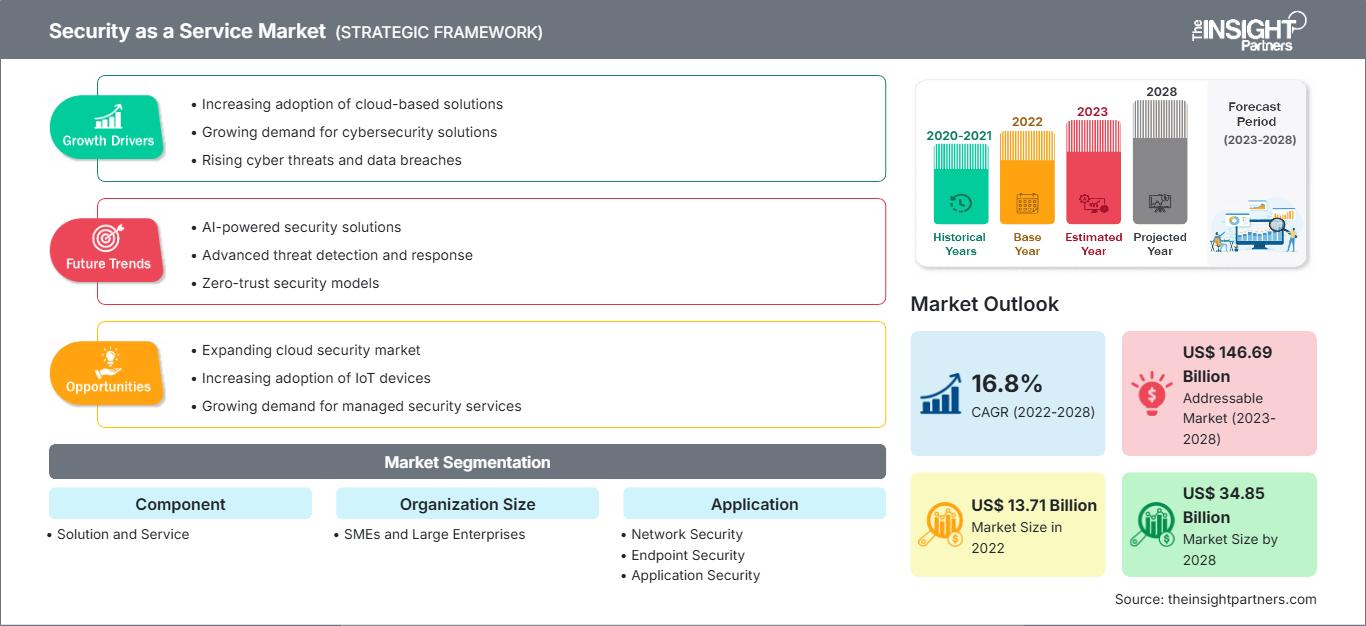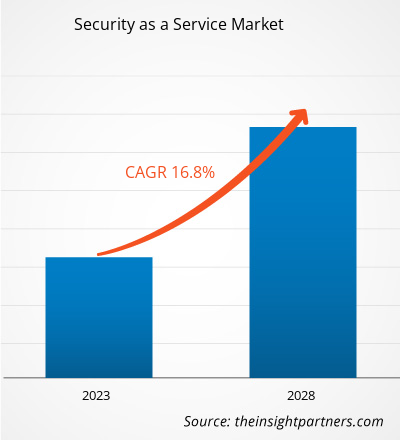Si prevede che il mercato della sicurezza come servizio raggiungerà i 34.854,10 milioni di dollari entro il 2028, rispetto ai 13.712,87 milioni di dollari del 2022. Si prevede una crescita a un CAGR del 16,8% dal 2022 al 2028.
La sicurezza come servizio è una tecnica per fornire soluzioni di sicurezza a un'organizzazione per data center o gateway regionali. Poiché contribuisce a garantire un accesso sicuro alle app, è diventato un approccio cruciale per le aziende che intendono incrementare le proprie implementazioni mobile e cloud. Per aumentare la sicurezza delle applicazioni aziendali, vengono implementate diverse soluzioni di sicurezza. Prevenzione della perdita di dati (DLP), soluzioni di conformità, prevenzione avanzata del malware, broker di sicurezza per l'accesso al cloud che prendono decisioni e monitoraggio continuo sono solo alcune delle soluzioni di sicurezza offerte. I fornitori di servizi addebitano alle organizzazioni una tariffa mensile ragionevole per i loro servizi. Grazie a questi vantaggi, i settori di utilizzo finale si stanno avvicinando sempre più agli operatori del mercato, il che si prevede alimenterà l'espansione globale del mercato della sicurezza come servizio. Le organizzazioni utilizzano ampiamente la sicurezza come servizio perché offre numerosi vantaggi rispetto agli approcci tradizionali, tra cui operazioni più rapide, aggiornamenti antivirus continui, soluzioni convenienti e operazioni più rapide.
La domanda globale di soluzioni di sicurezza è in crescita anche a causa della crescente digitalizzazione e dell'utilizzo di servizi basati su cloud in diversi settori. Molte aziende hanno recentemente adottato app aziendali, linee guida BYOD (Bring Your Own Device), tendenze CYOD (Scegli il tuo dispositivo) e altre tecnologie. La preoccupazione per l'integrità e la riservatezza dei dati aziendali è cresciuta a causa di queste tendenze. Oltre 3,7 miliardi di persone utilizzano la posta elettronica a livello globale e 269 miliardi di email vengono inviate ogni giorno a seguito dello sviluppo di metodi di marketing elettronico. Ciò offre enormi opportunità agli hacker di inviare email di spam agli utenti per ottenere informazioni cruciali su di loro. La maggior parte dei problemi di sicurezza inizia con email di phishing utilizzate dagli hacker per indurre le vittime a fornire loro l'accesso ad account, credenziali di accesso o informazioni finanziarie prima di passare ad attacchi tecnici. Pertanto, la crescente importanza della sicurezza informatica promuove fortemente la crescita del mercato della sicurezza come servizio.
Personalizza questo rapporto in base alle tue esigenze
Potrai personalizzare gratuitamente qualsiasi rapporto, comprese parti di questo rapporto, o analisi a livello di paese, pacchetto dati Excel, oltre a usufruire di grandi offerte e sconti per start-up e università
Sicurezza come mercato dei servizi: Approfondimenti strategici

- Ottieni le principali tendenze chiave del mercato di questo rapporto.Questo campione GRATUITO includerà l'analisi dei dati, che vanno dalle tendenze di mercato alle stime e alle previsioni.
Potrai personalizzare gratuitamente qualsiasi rapporto, comprese parti di questo rapporto, o analisi a livello di paese, pacchetto dati Excel, oltre a usufruire di grandi offerte e sconti per start-up e università
Sicurezza come mercato dei servizi: Approfondimenti strategici

- Ottieni le principali tendenze chiave del mercato di questo rapporto.Questo campione GRATUITO includerà l'analisi dei dati, che vanno dalle tendenze di mercato alle stime e alle previsioni.
Impatto della pandemia di COVID-19 sulla crescita del mercato della sicurezza come servizio
La continua crescita del numero di pazienti affetti da nuovo coronavirus ha costretto le autorità governative a imporre rigidi lockdown negli Stati Uniti e in altre regioni nei primi tre trimestri del 2020. Il settore manifatturiero ha subito gravi perdite a causa delle chiusure temporanee delle fabbriche, mentre la maggior parte delle aziende è stata costretta a passare al lavoro da remoto. La crescente adozione della politica di lavoro da casa ha innescato un aumento degli attacchi informatici e della necessità di protezione da essi. Le piccole e medie imprese sono state costrette ad aumentare la spesa per soluzioni di sicurezza di rete. In assenza di tali effetti della pandemia, le dimensioni del mercato della sicurezza come servizio hanno subito un impatto positivo. Negli Stati Uniti, si è registrato un forte aumento della distribuzione di phishing e malware con esche a tema COVID-19 e della registrazione di nuovi nomi di dominio con termini correlati al coronavirus o al COVID-19.
La regione ha anche assistito a un aumento delle transazioni online, che ha ulteriormente attratto i criminali informatici. Di conseguenza, le aziende hanno iniziato a concentrarsi sull'infrastruttura di sicurezza informatica per proteggere clienti e dipendenti. Ciò ha creato grandi opportunità di crescita per gli operatori del mercato. Microsoft ha riferito che tra febbraio e maggio 2020, sono stati rilevati 19 milioni di attacchi di phishing e ransomware a tema COVID-19 anche nella regione Asia-Pacifico. Poiché durante la pandemia diverse persone sono state costrette a lavorare in ambienti meno sicuri creati in fretta, il crescente utilizzo di servizi basati su cloud è diventato un punto caldo per gli attacchi informatici. Pertanto, il COVID-19 ha influenzato positivamente la crescita del mercato globale della sicurezza come servizio.
Approfondimenti di mercato - Mercato della sicurezza come servizio
Le significative prospettive di mercato sono create dall'ascesa dell'e-business, dalla crescente consapevolezza della protezione dei dati, dalla tendenza al modello BYOD (Bring Your Own Device) e dall'accettazione di misure di sicurezza gestite. L'uso delle tecnologie cloud è cresciuto significativamente nel tempo, aumentando la domanda di soluzioni di sicurezza più affidabili e convenienti. L'infrastruttura IT è diventata più complessa ed eterogenea negli ultimi 5 anni a causa dell'introduzione di nuove piattaforme, normative BYOD, tendenze CYOD, app aziendali e altre tecnologie. BYOD e tendenze CYOD stanno diventando sempre più comuni in ambito aziendale grazie ai rapidi miglioramenti del mobile computing. Le organizzazioni stanno sottoscrivendo servizi di sicurezza per proteggere i dispositivi, come smartphone, tablet, computer desktop e laptop, dai pericoli informatici a seguito dell'adozione del modello BYOD. Tali tendenze stanno intrinsecamente guidando il mercato della sicurezza come servizio.
Approfondimenti basati sulle dimensioni dell'organizzazione
Il mercato della sicurezza come servizio, in base alle dimensioni dell'organizzazione, è segmentato in grandi imprese e PMI (Piccole e Medie Imprese). Si prevede che il segmento delle PMI registrerà un CAGR più elevato durante il periodo di previsione. Secondo la Banca Mondiale, le PMI contribuiscono a circa il 40% del PIL e a circa il 60% dell'occupazione totale nelle economie emergenti. Con il crescente numero di PMI concentrate sulla semplificazione delle operazioni e sulla riduzione dei costi operativi, gli operatori del mercato della sicurezza come servizio stanno assistendo a una domanda significativa di soluzioni di sicurezza da parte di questo segmento. Poiché la digitalizzazione apre nuove strade per il segmento delle PMI, si prevede un tasso di crescita più elevato per questo segmento nel mercato della sicurezza come servizio.
Il mercato della sicurezza come servizio viene analizzato in base a componente, dimensione dell'organizzazione, applicazione e settore verticale. In base al componente, il mercato è suddiviso in soluzioni e servizi. In base alle dimensioni dell'organizzazione, il mercato è segmentato in PMI e grandi imprese. In base all'applicazione, il mercato è segmentato in sicurezza di rete, sicurezza degli endpoint, sicurezza delle applicazioni, sicurezza cloud e altri. In base al settore verticale, il mercato è segmentato in BFSI, Pubblica Amministrazione e Difesa, Commercio al dettaglio, Sanità, IT e Telecomunicazioni, Energia e Servizi di Pubblica Utilità, Produzione e altri. In base all'area geografica, il mercato della sicurezza come servizio è segmentato principalmente in Nord America, Europa, Asia-Pacifico (APAC), Medio Oriente e Africa (MEA) e Sud America (SAM).
Mercato della sicurezza come servizioMercato della sicurezza come servizio
Le tendenze e i fattori regionali che influenzano il mercato della sicurezza come servizio durante il periodo di previsione sono stati ampiamente spiegati dagli analisti di The Insight Partners. Questa sezione illustra anche i segmenti e la geografia del mercato della sicurezza come servizio in Nord America, Europa, Asia-Pacifico, Medio Oriente e Africa, America Meridionale e Centrale.
Ambito del rapporto di mercato sulla sicurezza come servizio
| Attributo del rapporto | Dettagli |
|---|---|
| Dimensioni del mercato in 2022 | US$ 13.71 Billion |
| Dimensioni del mercato per 2028 | US$ 34.85 Billion |
| CAGR globale (2022 - 2028) | 16.8% |
| Dati storici | 2020-2021 |
| Periodo di previsione | 2023-2028 |
| Segmenti coperti |
By Componente
|
| Regioni e paesi coperti | Nord America
|
| Leader di mercato e profili aziendali chiave |
|
Densità degli attori del mercato della sicurezza come servizio: comprendere il suo impatto sulle dinamiche aziendali
Il mercato della sicurezza come servizio è in rapida crescita, trainato dalla crescente domanda degli utenti finali, dovuta a fattori quali l'evoluzione delle preferenze dei consumatori, i progressi tecnologici e una maggiore consapevolezza dei vantaggi del prodotto. Con l'aumento della domanda, le aziende stanno ampliando la propria offerta, innovando per soddisfare le esigenze dei consumatori e sfruttando le tendenze emergenti, alimentando ulteriormente la crescita del mercato.

- Ottieni il Sicurezza come mercato dei servizi Panoramica dei principali attori chiave
Alert Logic, Inc., Barracuda Networks, Inc., IBM Corporation, McAfee LLC, Microsoft Corporation, Radware, Trend Micro Incorporated, Clearswift, Silversky, Zscaler, Inc. sono i principali attori del mercato della sicurezza come servizio.
Gli attori del mercato si stanno concentrando fortemente su fusioni e acquisizioni. Ecco un'istantanea dei recenti sviluppi nel mercato della sicurezza come servizio:
- Nel 2022, HelpSystems ha annunciato i suoi piani di acquisizione di Alert Logic per fornire ai clienti un approccio IT ibrido per affrontare la carenza di competenze in materia di sicurezza informatica.
- Nel 2022, IBM Corporation ha annunciato i suoi piani di acquisizione di Randori, un fornitore di protezione informatica offensiva e gestione della superficie di attacco. Secondo ITPro, IBM intende combinare il software di Randori con le funzionalità di rilevamento e risposta estese (XDR) di IBM Security QRadar.
- Analisi storica (2 anni), anno base, previsione (7 anni) con CAGR
- Analisi PEST e SWOT
- Valore/volume delle dimensioni del mercato - Globale, Regionale, Nazionale
- Industria e panorama competitivo
- Set di dati Excel
Report recenti
Rapporti correlati
Testimonianze
Motivo dell'acquisto
- Processo decisionale informato
- Comprensione delle dinamiche di mercato
- Analisi competitiva
- Analisi dei clienti
- Previsioni di mercato
- Mitigazione del rischio
- Pianificazione strategica
- Giustificazione degli investimenti
- Identificazione dei mercati emergenti
- Miglioramento delle strategie di marketing
- Aumento dell'efficienza operativa
- Allineamento alle tendenze normative






















 Ottieni un campione gratuito per - Sicurezza come mercato dei servizi
Ottieni un campione gratuito per - Sicurezza come mercato dei servizi